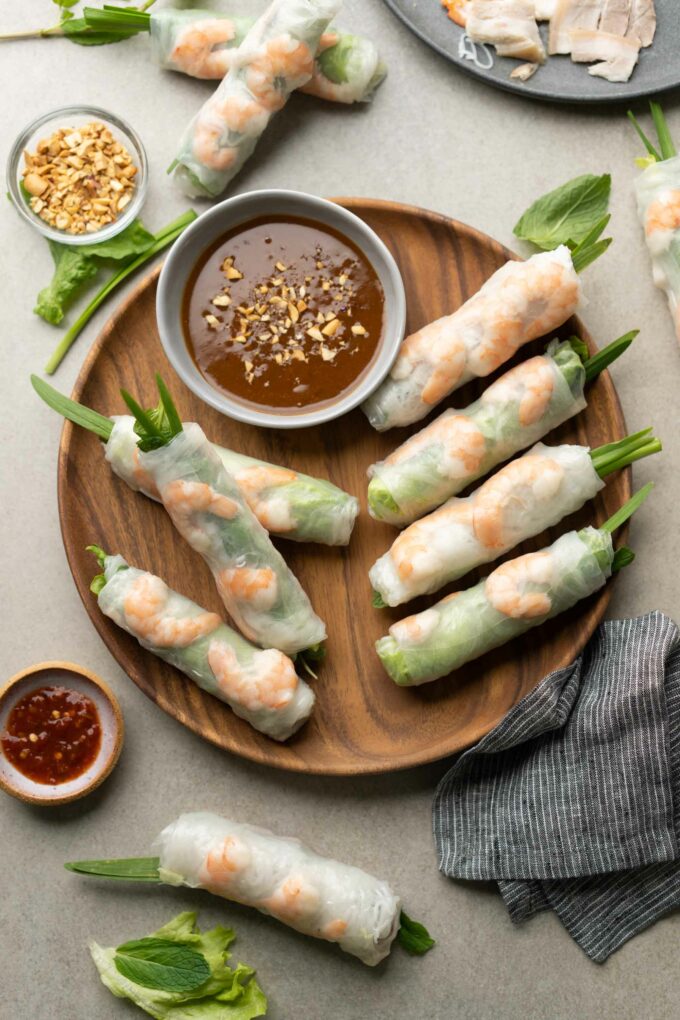
This traditional Vietnamese Spring Roll recipe (gỏi cuốn) is full of fresh veggies, herbs, soft slices of pork, and shrimp all brought together with a super flavorful hoisin and peanut dipping sauce.
What are Vietnamese spring rolls or gỏi cuốn?
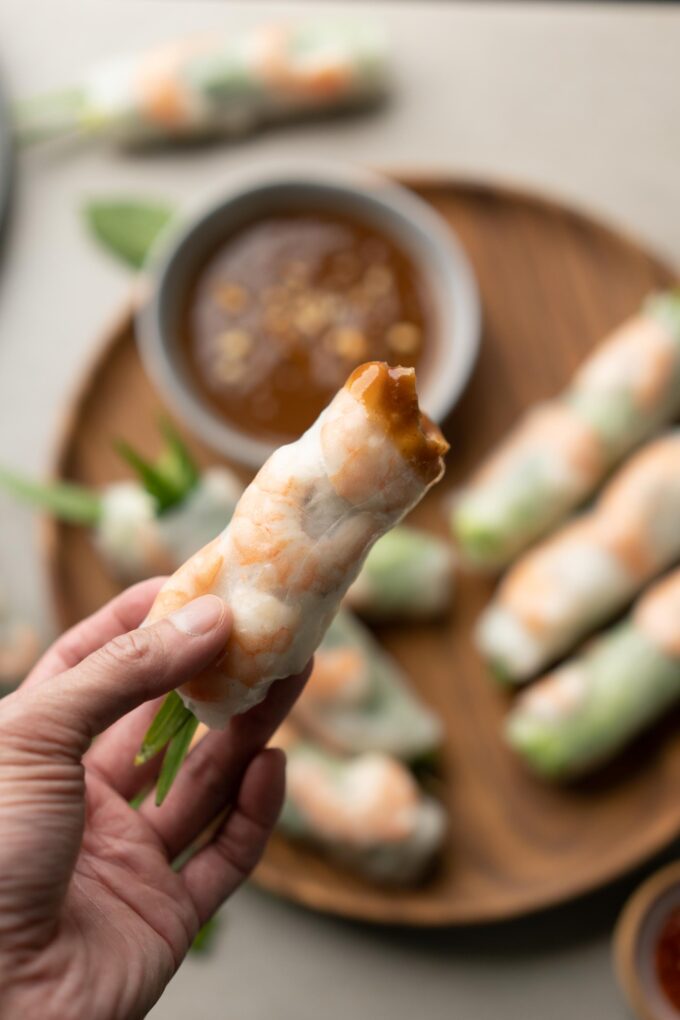
Gỏi cuốn literally means salad rolls, and for the longest time I never made that connection. I just assumed it was a random name for these rolls, silly me.
But these tasty little rice paper rolls are indeed an herby salad mixture, with pork, shrimp, and rice noodles. Dip it in as much sauce (or should we say salad dressing) as you’d like. I love gỏi cuốn–they’re tasty and fun to eat. They’re great as a communal meal where everyone is rolling their own at the table.
Mom says gỏi cuốn or Vietnamese spring rolls were something people never made at home in Vietnam. It has so many components, and is quite an undertaking to prepare. It was crazy to even think of making it yourself when there were literally street vendors selling these outside your house just about everywhere.
Vietnamese spring rolls were meant to be just an appetizer and never a full meal. Although when growing up, her family didn’t always have money to spend on snack foods like this.
What’s in spring rolls?
There are many ways to make spring rolls, but let’s talk about what’s in traditional fresh Vietnamese spring rolls:
- rice paper wrapper
- thin rice noodles
- leafy lettuce, red or green
- herbs, primarily mint. but optionally chives, cilantro, whatever you have on hand
- thinly sliced pork (belly preferred) and boiled shrimp
- dipped in hoisin and peanut based sauce
The rice paper wrapper: bánh tráng
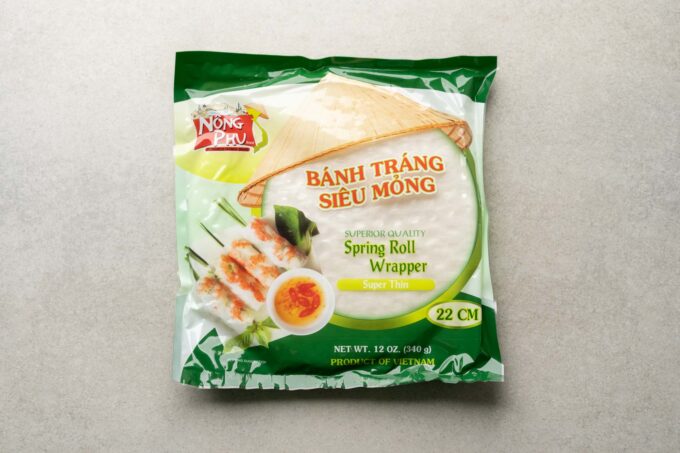
Typically made from just rice and water, the rice paper (bánh tráng) could be easily used for lots of other things. At one Vietnamese market, over five brands of this stuff. All with multi-lingual packaging: Vietnamese, Chinese, English, and French.
During the pandemic right now, the supply chain is wrecked so I was hard pressed to find five brands, and had to hit up three markets to find one brand. And it was smaller than optimal size too but you can make any size work.
Ingredients in the rice paper wrapper
Rice paper or spring roll wrappers in America tends to have tapioca flour added, and isn’t pure rice flour, to increase the strength of the paper. It makes it easier to handle and roll without breaking.
However typically in Vietnam you can get ones that are actually 100% rice flour. We’re lucky enough to have family that visits Vietnam often enough and were nice enough to bring back the super thin 100% rice flour wrappers for us. The thinner wrapper makes the wrapping and eating experience a bit different–since it’s thinner it highlights the filling ingredients more instead of making you full off wrapper.
Spring roll wrappers used worldwide
Bánh tráng is not just something Vietnamese people eat. Cambodian people have a similar roll made of the same rice paper called nime chow–it’s a meatless version dipped in a vinegar-based sauce instead of hoisin. The Chinese have a version with duck and cucumber with a hoisin based dipping sauce. Japanese restaurants are also commonly using regular and dyed versions of rice paper for rolls too.
The meat: pork belly and shrimp
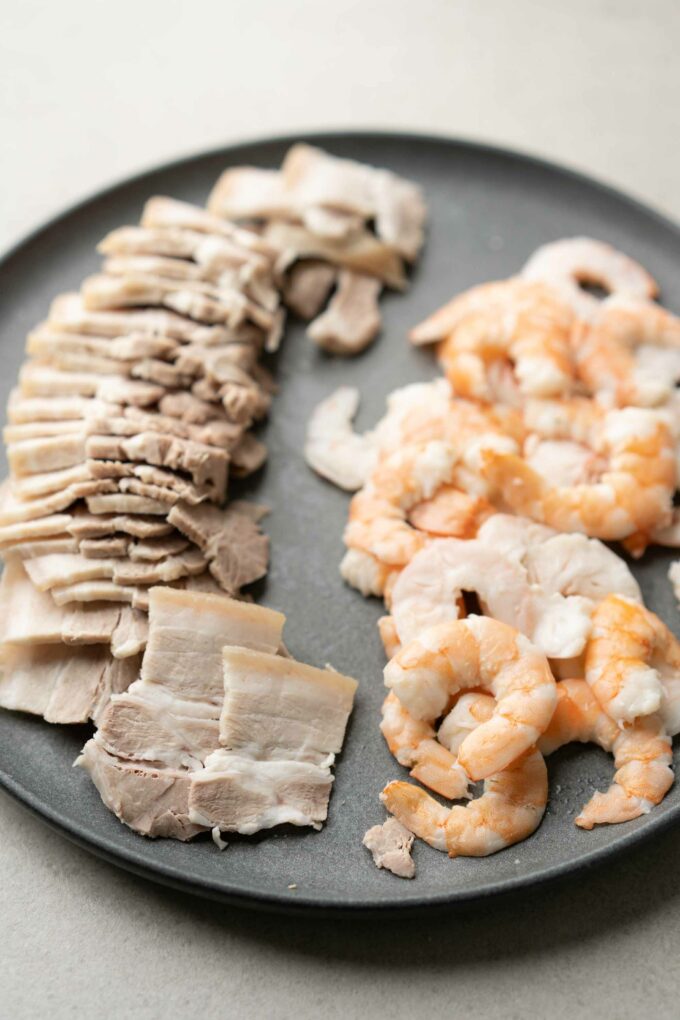
The most common and traditional meat fillings for gỏi cuốn or Vietnamese spring rolls is pork and shrimp. Nowadays you can find vegetarian versions and new twists on this with fancy beef cuts and others but if a place only makes one variety you can bet it’s gonna be pork and shrimp.
For the pork, you will typically find leaner cuts since it’s cheaper. Since we’re making it at home, we’re gonna fancy it up with fattier, better tasting pork belly!
For the shrimp, medium sized shrimp around size 31/35 is ideal. If your market doesn’t stock it, you can go a little larger or smaller and it will be fine. The medium size just makes wrapping easier. Just keep in mind when planning out your roll sizes that shrimp will shrink a little when you cook it.
How to easily devein shrimp
Like any creature that eats food, it has a digestive tract. We call it a vein because we’re all kidding ourselves about what’s really happening here: it’s poop y’all. Lets remove that shrimp vein / digestive tract! (Also see my tutorial on 3 ways to peel and devein shrimp.)
But here’s one easy way to devein shrimp I learned from my mom! It requires much less precision and best of all it is FAST!
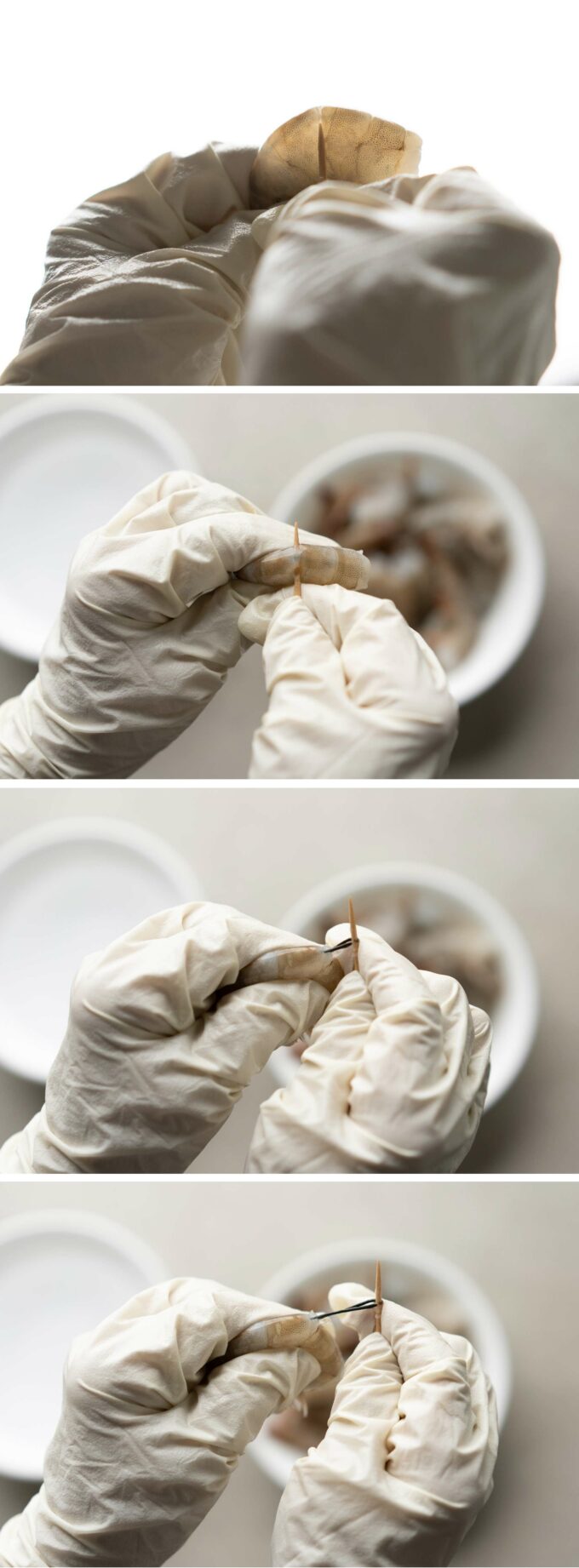
- Defrost your shrimip by soaking it in lukewarm water until its no longer frozen. This will not work if the shrimp is frozen. (By the way most shrimp in America is frozen, even the stuff in your butcher’s counter was previously frozen then defrosted).
- Grab a toothpick and hold the shrimp up to a light source to locate the vein.
- Now locate the joint of the shrimp shell–it will be lighter in color than the rest of the body. Move the toothpick a little bit below the vein and push the toothpick all the way through the shrimp.
- Gently lift the toothpick outwards towards the back of the shrimp, breaking through the shell along the way. Do this slowly so the vein has a better chance of staying intact. If successful you’ll see the vein pull out.
- Sometimes you may miss and a clear string or nothing comes out, or the vein breaks. It’s ok! Just find another spot along the shrimp to repeat until the shrimp is clear of veins.
- Clean the toothpick in a bowl of water or paper towel and repeat on the rest of your shrimp.
The rice noodles (& a noodle hack!)
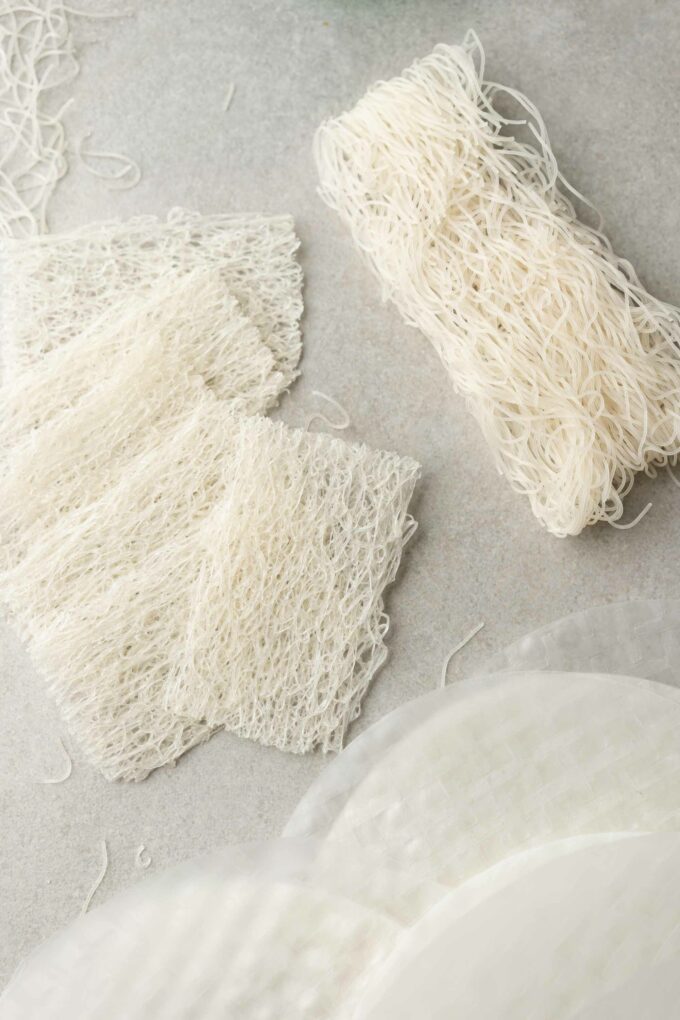
I recently learned a cool trick from my mom for this recipe: use bánh hỏi instead of regular rice noodles. Bánh hỏi is what you see above on the left–they’re sheets of noodles typically used to eat with grilled meat. These come dried in small rectangular sheets and you boil them just like other rice noodles, or like pasta.
Working with bánh hỏi is much less sticky, and way easier to move around, trim, and arrange in your spring rolls. This is a huge shortcut in my opinion!
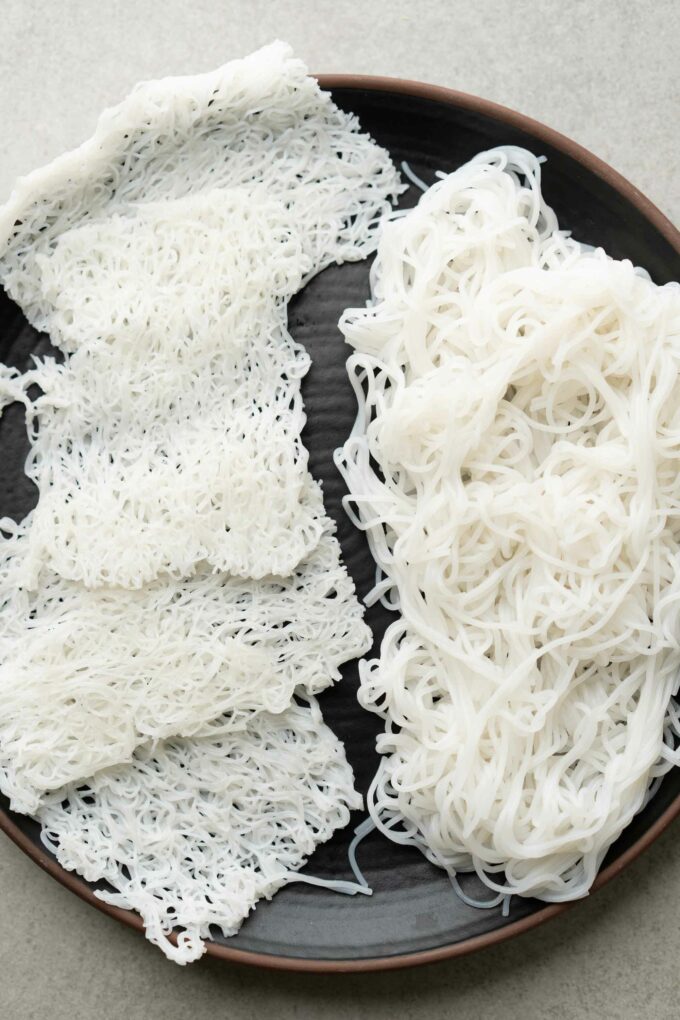
If you can’t find any bánh hỏi in your local Asian markets normal rice noodles work just fine. Go for the thin noodles to make it easier to arrange in the spring roll. And again if you can’t find thin ones, medium thickness will be ok too.
Whichever noodle choice you go with, cook them according to the package’s instructions, then rinse and drain to cool and stop the cooking process. After it drains, you can spread it out on a plate a bit before all the noodles clump and stick in a large mass in your strainer.
Vegetables and herbs for Vietnamese spring rolls
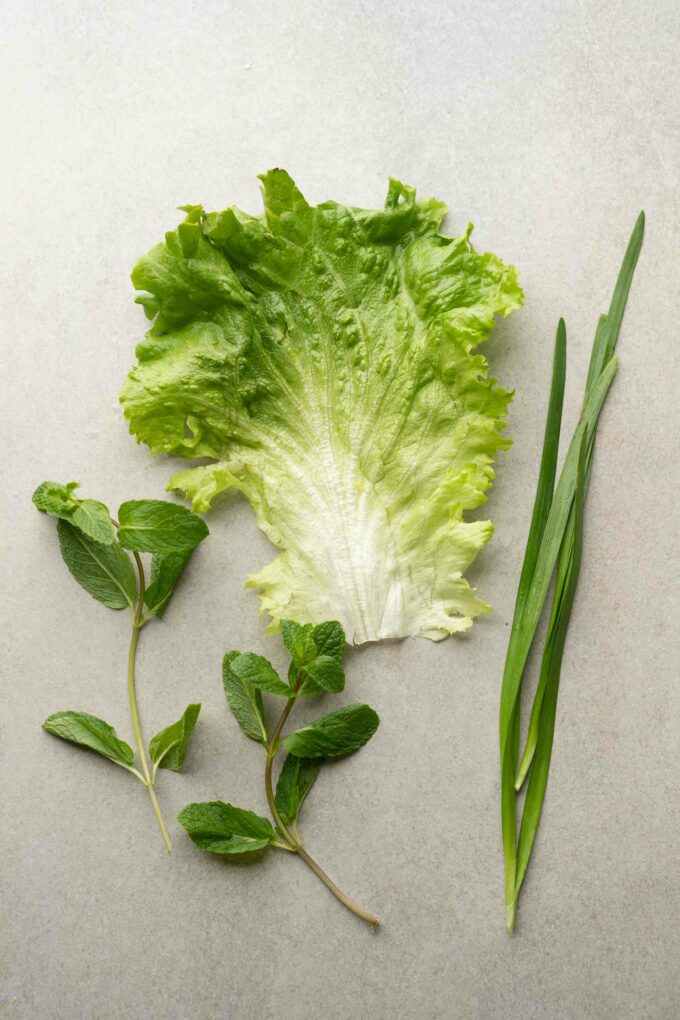
Anytime I ask my mom or aunts about what ingredients goes in something, the answer usually is some form of “whatever you want” which is always hilarious but not super helpful to me.
The most common vegetables and herbs for Vietnamese spring rolls are simply a green leaf lettuce and mint. You can go for any soft, leafy green or red leaf lettuce as long as its soft.
Chives are a bonus if you like the flavor, and for a little bit of visual flair but you can compmletely omit the chives if you’d like and still keep these authentic and traditional.
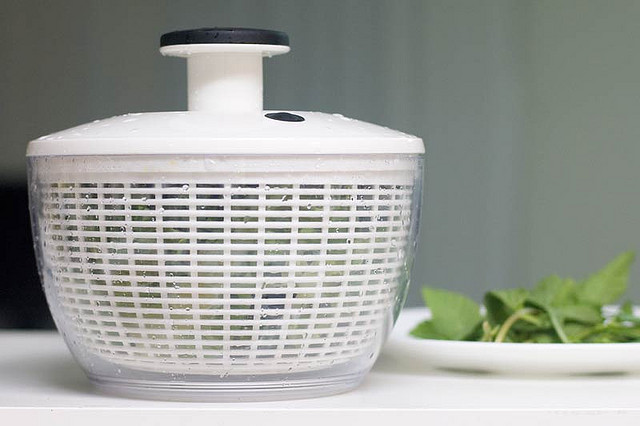
One tip for washing and drying your veggies is to use a salad spinner–its amazing how fast this thing can dry veggies. I love using my OXO Salad Spinner which I’ve now owned for over 15 years.
How to wrap Vietnamese spring rolls
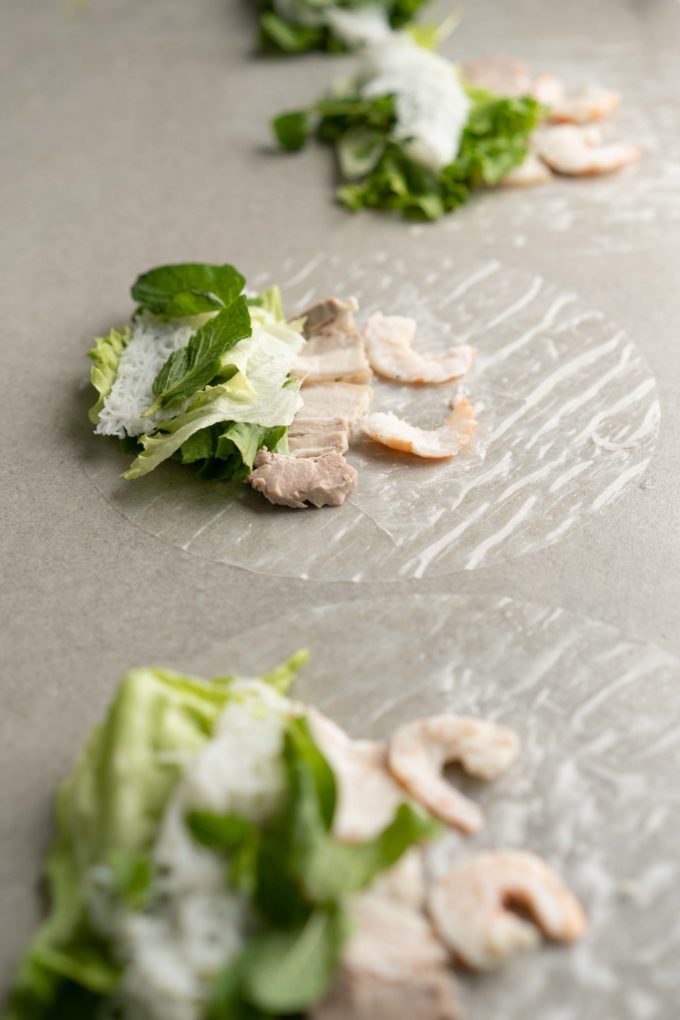
There are seemingly inifinite ways to successfully, cleverly wrap up a fresh Vietnamese spring roll. I’ve created an in-depth guide on a separate post on how to wrap Vietnamese spring rolls with many tips on how to roll a ton of these quickly.
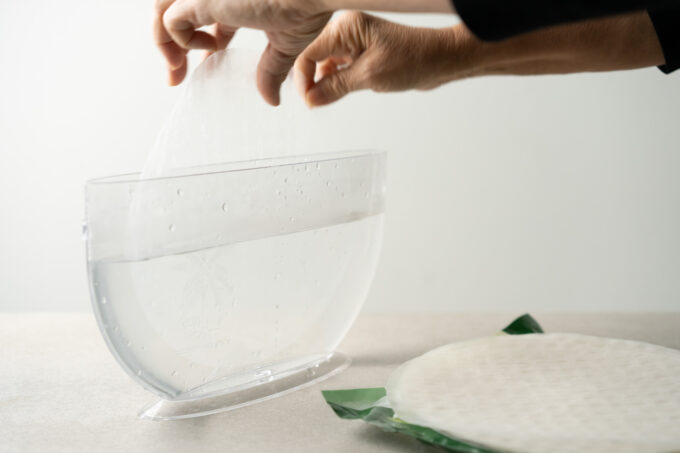
One of my favorite tips no matter which way you roll is to use this fancy rice paper water bowl to dip the sheets in. It will save you a ton of counterspace when you have a table full of guests!
Tips for making spring roll dipping sauce
- Use a garlic press so the garlic is small and its flavor is evenly spread throughout the dipping sauce.
- The sauce will appear a little thin when done, but it will thicken a bit after it cools. If you really want it thicker you can cook down the sauce more, or omit some water.
- Scoop out sauce into serving bowls instead of dipping straight into a communal bowl. This way leftover sauce will keep longer in the fridge.
The recipe is below, but if you want more photos and tips check out my post dedicated to Vietnamese peanut sauce.
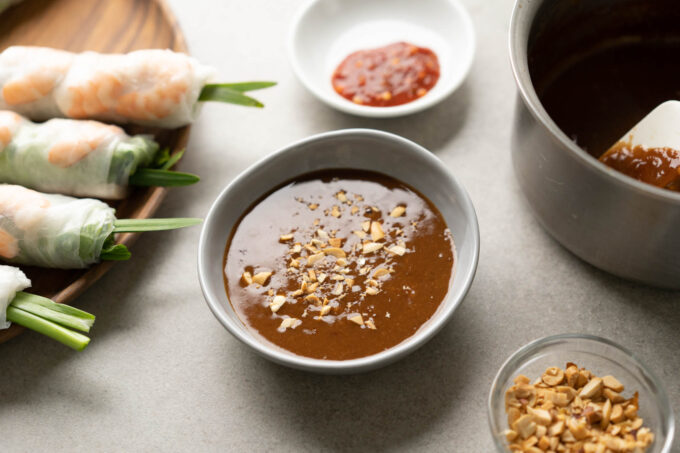
What are Vietnamese spring rolls made of?
Traditional Vietnamese spring rolls can be made of many different fillings like vermicelli noodles, mint or other herbs, leafy greens, shrimp, pork, shrimp, and other vegetables inside a tight rice paper wrapper.
Can you make Vietnamese spring rolls ahead time?
Yes you can, but only a few hours ahead. You don‘t want to make this a day ahead. The longer the spring rolls sitting the drier the wrapper will get. Reheating spring rolls isn’t great because the wrapper will be unevenly hydrated, and you will have to heat the lettuce inside, which gets weird. Some restaurants that cater individually wrap these rolls in plastic wrap to keep them from drying out.
What is a spring roll wrapper made of?
Spring roll wrappers in America are commonly made of rice flour, tapioca flour and water. You might be able to find some with only rice flour and water, which is the more common ingredient list for wrappers found in Vietnam.
How do you keep Vietnamese spring rolls from sticking?
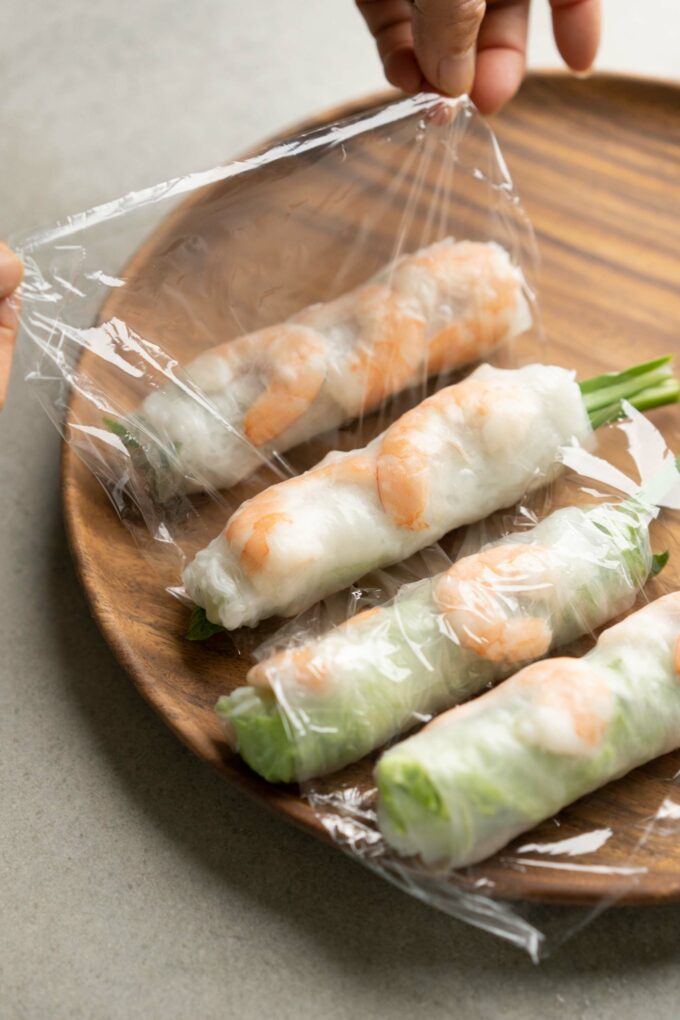
When assembling rolls: When you dip the dried rice paper into the water, it really only needs 1-2 seconds of a quick dip in warm water, then transfer to your rolling surface. Then assemble your ingredients and roll shortly after–do not wait! The paper will continue to hydrate and soften as it sits on the table and will get super sticky if you wait too long.
Prevent assembled rolls from sticking to each other: Do not place completed rolls next to or on top of each other because the rice paper WILL stick. If you need them to be packed tight you can individually wrap each roll in plastic wrap.
Or see the photo above for a quicker way to assemble rolls on a plate or tray–use plastic wrap to separate each roll by weaving the cling wrap over and under each roll. A huge time saver if you don’t need to wrap each one individually!
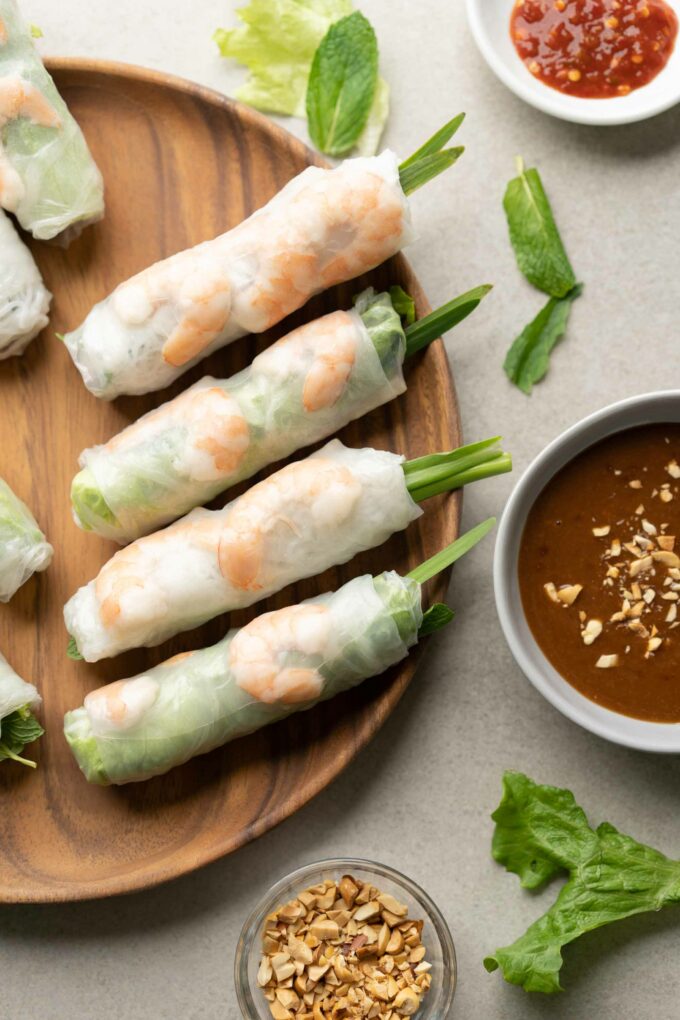
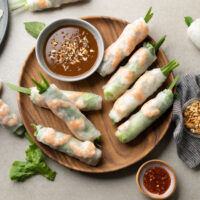
Vietnamese Spring Rolls Recipe (Goi Cuon)
Ingredients
Pork
- 1/2 lb (226.8 g) pork belly
- 1 medium onion halved
- 1 tsp sugar
- 1 tsp salt
Shrimp
- 1/2 lb (226.8 g) shrimp 31/35 size
- 1/4 tsp salt
Veggies and Other Ingredients
- 1 head green leaf lettuce or red leaf lettuce
- 1/2 bunch mint
- 1/2 bunch chives
- 1/2 pack dried spring roll wrapper (rice paper)
- 1/3 pack dried rice noodles or dried bánh hỏi
Peanut Dipping Sauce
- 2 tbsp oil
- 2 tbsp minced garlic
- 8 tbsp hoisin sauce
- 2-3 tbsp peanut butter
- 1/2 c water
- Sambal chile paste to taste, optional
Equipment Used
Instructions
Cooking Pork
- Add pork, onion, salt and sugar to a small pot and add enough water to cover about 1 inch above the pork. Bring to a boil on high heat and then lower to medium and cook for about 25-30 minutes or until pork juices run clear when poked at the thickest part, or it registers 145 F with an instant read thermometer at the thickest part.
- Cover the pork in a bowl as it cools so it doesn't darken. Once cool, slice the pork as thinly as you can to make rolling easier later.
Cooking Shrimp
- Defrost shrimp in water bowl. Once defrosted, de-vein the shrimp. Hold a shrimp up to a light to locate the vein, pierce the whiter part (joint) of the shrimp just below the vein with a toothpick, and pull the toothpick upwards towards the shrimp back. Do this slowly to remove the vein. Piece again at another joint if the vein breaks to remove all traces of vein. Repeat with all your shrimp.
- Cook the shrimp: add shrimp, salt, and enough water in a small pot to barely cover your shrimp. Boil on medium-high heat for only about 1.5 to 2.5 minutes or until the shrimp is no longer translucent. Drain and run under cold water to stop the cooking process.
- Remove the shells and tails from shrimp, and cut the shrimp in half along the body.
Rice noodles
- Cook either your rice noodles according to the package instructions. Timing can vary wildly depending on noodle thickness and brand. This can be anywhere from 2 to 10 minutes. Drain and cool the noodles under cold, running water to stop it from cooking further.
Veggies
- Prepare your vegetables by rinsing and drying them.
Spring Roll Wrapping (Full Wrapping Guide)
- Add warm water to a plate and soak the rice paper sheet for about 5-10 seconds. Soak the rice paper just enough so that it is pliable and easy to handle, but remove the sheet before it gets too soft and sticky. Lay rice paper on a plate and begin to assemble your roll.
- Add lettuce towards the bottom of the rice paper. Leave 1 to 1½ inches of space on either side of the rice paper. Layer with mint and chives. Try to not add too many items because it will be harder to roll and might tear your rice paper.
- Add shrimp in the middle of the rice paper with the orange skin facing down.
- Layer the sliced pork on top of the shrimp.
- Add the noodles across the vegetables, spread evenly across.
- Fold the left and right sides towards the middle so that it's snug. Lay some chives lengthwise with one end poking out. Then fold the bottom up to cover the noodles. You want to keep the roll tight, so lightly squeeze it together as you roll. Continue to roll upwards to complete the spring roll.
Peanut Dipping Sauce (Full Recipe Post Here)
- In a pan over medium heat, saute garlic in oil until fragrant.
- Add in hoisin sauce, peanut butter, and water and mix thoroughly.
- Bring to boil, and then immediately turn off the heat and pour into a heat safe dipping bowl. The sauce will slightly thicken as it cools.
- Sprinkle ground peanuts on each sauce dipping bowl, and leave the chile paste on the side so others can add to their own dipping bowl as desired.


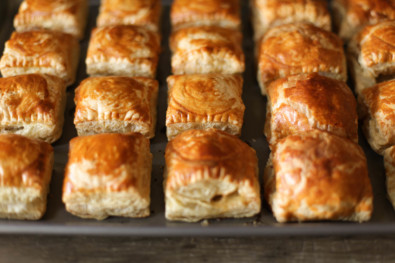







huy, you are hungry!
pear!: gotta stay hungry too 🙂
Rachel: Yeah! I also didn’t think it would be so simple. It kinda reminds me of Hu Tieu: rice noodles, pork, shrimp, and you dip the meat in hot sauce and hoisin sauce.
Thanks so much for the informative post – the photo essay makes me feel like even I could do this!
I had no idea that the sauce that so often comes with goi cuon was only thinned out hoisin garnished with nuts and sambal! That rules.
Hey Rachel, I’ve updated the recipe for the sauce which is a bit more complicated, but way better now!
ohh these look delicious. my dad likes using the hot plate with butter. ill try boiling them next time.
oops one more thing where do you buy that salad spinner thing? my mom wants one but we cant find it anywhere
Try Amazon.com. A bit pricey, but it leaves the lettuce bone-dry!
Ikea has one that’s a little on the flimsy side, but does the job and is low price
I could never roll the spring roll correctly. It always comes out bulky. Your step by step pictures is really simple to follow. I’ll try it to see if my rolls come out right next time. Nice post!
Thanks! It took me a few rolls to get it down. At first there was way too much filling. Eat the first one you make to get a feel for how much of each ingredient you want in the roll.
My mom mixes the hoisin sauce with some peanut butter and warms it a bit on the stove. Mmm~!
Thanks for the tip! That’s tasty too. I’m going to make some more tonight.
Hey Huy! Love this recipe and I have made it once already & planning to make it again tonight! Its a staple at my house to each fresh spring roll once a week, so easy & yummy! thanks for the share!!
Interesting. My rolling technique is a bit different but I will give yours a try.
I make my rolls with pork that has been pounded almost paper thin and then braised with a barbeque sauce, if I use pork or chicken at all.
Also, I never add heat to my hoisin/peanut based sauce. I may add a few pepper flakes with the chilled fish sauce that I also serve my rolls with but never the dark.
Thank you for your recipe. I really like the step by step photos. It makes it so easy for individuals who have never made a dish before to understand the preparation.
Thanks for sharing this Huy! I went and bought a pack of the rice paper a week or so ago after having twice enjoyed “summer rolls” recently. I googled cuon because that’s all the clues they have on the packet. I was afraid to do the soaking wrong. I was thinking to improvise anyway, but how lovely to come across your well-written, photo-illustrated post. Now I’m confident I’ll be able to make these even though my first batch is going to be not at all authentic because I am missing some ingredients that I think would make them better. However, I’m going to give the techniques and general idea a whirl and get more things in my next supermarket trip!
🙂
Thanks for stopping by! Don’t be afraid to do it wrong–I mess things up all the time :). The rice sheets are fairly cheap. Start out with water that isn’t too hot so you can adjust the softness with soak time more easily.
yummy ! i want to eat ^^
Thank you for your posting, the photos and etc. I plan to have a make it yourself goi cuon party and came across your site. Thank you!
Looks like a great recipe. I see that in the pictures you have chili paste, but it doesn’t seem to be in the recipe. Are you supposed to add a little to the dipping sauce?
Hey Christina, the chile paste is optional and I leave it out so each person who eats from it can add as much or as little as they like. But I’ll note that in the recipe, thanks!
What kind of pork do you use? It looks pretty lean. Is it by chance a pork tenderloin or is it a pork butt/pork shoulder?
Hey Huy, If you you squeeze half of lime juice or lemon to the warm water that will keep the spring roll last a bit longer . The moist will remain with the roll instill the end of the day.
Thanks for the tip Larry!
I have made these for years. I don’t remember where I got the original recipe but it differs somewhat from this. Differences:
Chop thin cut uncooked pork into thin slices. Mash garlic – a lot of it in a garlic press. Saute together. When done add a couple dashes of soy sauce and small amt fish sauce and simmer until liquid evaporated. Cool.
Slice Romaine lettuce leaves (remove large spines), basil, mint into thin strips. Keep in separate piles.
Roll rice noodles, generous amount of lettuce, several pork slices, a scant sprinkle of mint and basil. (I roll on a lightly oiled wooden block) Wrap in wax paper being sure to separate rolls with the paper. Store in fridge. Will keep for 2 – 3 days, if you can keep them around that long.
Question! I’m planning on making this on the day I am going to a party and bringing it. What is the best way to store it and keep it fresh? I am guessing there will be 2-3 hours between the time I finish making them and the time I arrive at the party.
Can we make this fresh spring rolls one day a head time ?
Hi Huy! Do you use “thit ba chi” for the pork? I know it says pork leg and I’ve asked my mom and she says to buy thit ba chi. Lol
Great recipe and great step by step pictures! Thanks so much! Easy enough even for me and spring rolls we’re delicious!
So glad it worked out for you, thanks Annie! I saw a demo in Vietnam recently where they were teaching people how to roll these–so many eager participants doing pretty well on their first go!
I’ve eaten these for years. Same place but they are sooooooooooooo popular that they keep getting a little harder (older) and a little simpler (fewer ingredients) every year and they are still soooooooo good we just put up with the situation. Once in a while we actually make them. Then we remember how good they really were back then.
Looks fantastic, will be making these for New Years Eve. Thank you for sharing!
Absolutely DELICIOUS!! My husband and I are super fans of Vietnamese cooking…..and eating 🙂 The dipping sauce is out of this world! Thanks so much for the authentic and wonderful recipe. We will keep this one in the rotation for sure!!
It may sound revisionist, but I’ve been making a chopped spring roll salad without the rice paper for years. No complaints, even accolades with empty bowls. The dip becomes the dressing. I’ve also been known to economize by using surimi in place of shrimp, and char sui . I’ve also put the chopped salad in spring rolls, not as pretty, but easier. Love your inspirations and recipes on many other foods..
Another excellent recipe! This came out delicious and was a big hit with even my picky eaters. We also added avocado strips.
How far in advance can I make the sauce? Do I refrigerate it if using several hours later?
Thanks ! Eddie
The wrapper can begin to dry out and harden if uncovered or left out. Some people cover it in plastic wrap to extend the life a bit. Refrigerating will also harden it, and reheating kinda ruins the quality. We get by with prepping a few hours ahead, but the best way is to roll it as soon as you can to mealtime 🙂
Loved the toothpick idea. Entire article was very thorough and detailed. Excellent post. Thanks.